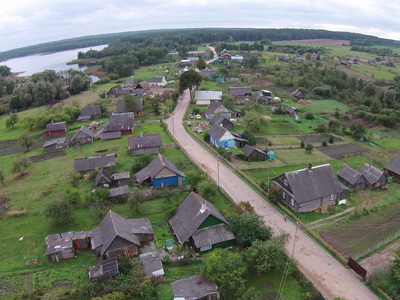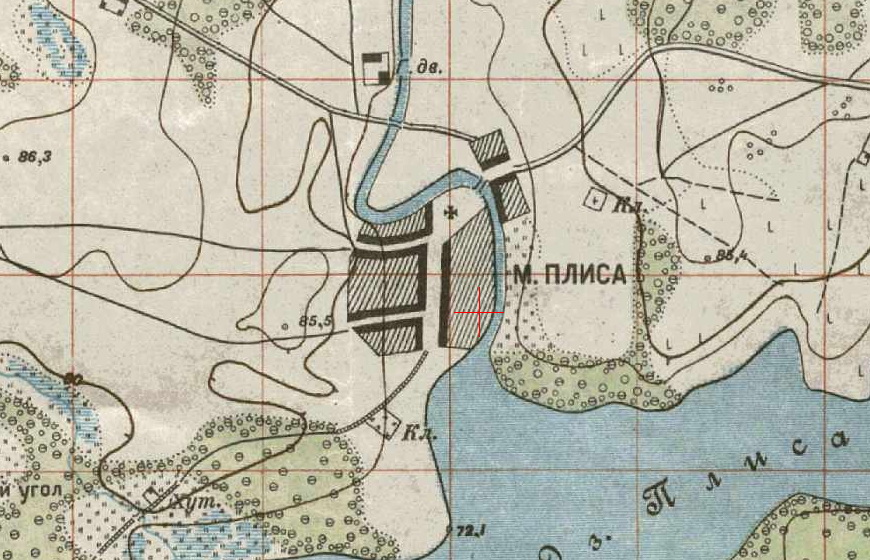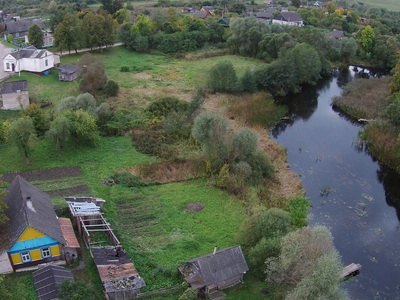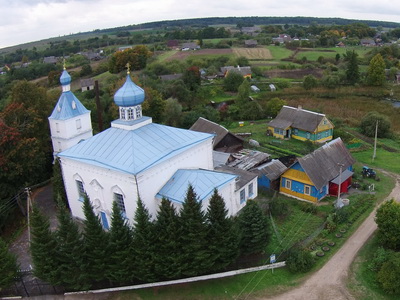Belarus genealogy tours
Special guided Minsk tours aimed at the field Belarus family research.Pliskin from Plisa (Plissa)
Plisa Village near Plisa Lake
The map of Belarus lists many Plisas – rivers, lakes and villages. Historians assume the name originates from ples – a still place in a lake or river that hasn’t become overgrown with grass. Lake near Plisa is also called Plisa and is 6 kilometers long, 1.5 kilometers wide and over 15 meters deep. Beside the lake is a castle mound that was once topped by a fortification.
Accidental archaeological finds near the local rivers Lutitsa and Mniuta and the lake helped to estimate the age of the first human settlements in the area at 3000 years. Official history of Plisa started only in 1507 when a purchase deal was concluded in writing, the village sold by its owner hetman Konstantin Ostrozhsky.

Plisa Village air view
In the late 19th century Plisa numbered 75 houses with 650 residents. There was also the residence of the nobleman, 6 shops, 2 taverns, a mill built on the Mniuta river and a small brewery. Apart from the Russian Orthodox church there were a wooden Catholic church and a synagogue. Since 1939 Plisa was a part of Soviet Belarus and in the 1940s – district center. At the moment Plisa is only a locality center.
Plisa was mostly a village of wooden houses though a few masonries were located by the river. There was no running water, electricity was introduced only in 1939 and the toilets were outside. The economic situation was bad, but the villagers didn't starve.

Old map of Plisa area
Plisa is based on the way from Vilno to Polotsk. By the sides of the road people always erected stone crosses for protection against diseases, wars and evil people. The stone cross next to the local church was toppled and thrown off the hill in the Soviet time, but was recently recovered and put to its old use.
In 1887 a Russian Orthodox church was built in Plisa and was consecrated after Paraskeva Pyatnitsa. In the 1960s the church was closed down and later converted into a dance floor with a stage at the altar. The old basement burials weren’t violated so the dances literally occurred on the human bones. The cupolas of the church were torn off by the local activists. Upon the recovery of the building the locals started its restoration and brought some icons.
Plissa Jewish community
Plisa had a Jewish community, too. The relations between Jews and Belarusians were very good: Jews earned their living from crafts and trade, while Belarusians were mainly farmers and land owners. The whole Jewish community was religious - they were Lubawicz Hassidim (belonged to the Lubawicz Hasidic sect).
The community ran a synagogue, a mikve, a girls' school where all the classes were in Yiddish, a cemetery which also served various smaller villages around, Zionist movements, such as Hashomer Ha-Tsair, Beitar, a welfare association Gemilut Hassadim, a rabbi, a Mohel (circumcizer), a Shochet (animal slaughter according to Jewish law). There was even a Jewish bank, most probably owned by Jews.

Plisa old houses by the bank
The synagogue didn’t survive the war while the cemetery did – it can be found to the left from the road as you are driving from Dokshytsy. When the war started the Nazi weren’t immediately hostile and the locals stayed behind the frontline. On 1 June 1942 almost entire Jewish community was destroyed.
A former partisan now living in Israel, Moshe Tsimkind lost all his relatives in the ghetto. He recalls that a week after the occupation started most of the men were sent to work at the railroad. After they failed to return home it became clear that the local policemen executed them.
A few glimpses of Plisa, Glubokoye district, Northern Belarus... The Jewish community destroyed almost entirely on 1 June 1942, a few old properties still surviving.
Posted by Minsk Guide on Friday, 15 May 2015
Two locals including Stepan Metelitsa, a peasant who lived two kilometers away from Plisa, and Konstantin Ivankovich, Moshe’s classmate, offered several Jewish families a hiding place risking their own lives. Moshe recalls that many Jews didn’t even attempt to save their lives and seemed to have accepted their fate.
When the ghetto liquidation started on 1 June 1942 Moshe’s family like many others was forced out of the house. Moshe wasn’t caught only by accident, his life spared by another polizei – another classmate of his. The few survivors relocated to Glubokoye ghetto and while some collapsed in the latter, others including Moshe survived the war.
Looking for the traces of the Pliskin family
Armed with the memoirs of my guests' ancestors and some old maps that a good guide always has at hand we were looking for the following.
I forgot to mention how we lived. Our first house measured eighty-four feet by eighty-four feet. It was a corner house. It was on the main street; it had a large gate, and a large basement about twenty-eight square feet where ice was kept cool during the summer. In the yard there were large stables for horses and stables for eight cows and twelve goats. We also had a large storehouse to keep dry lumber a whole year. We had a silo to keep hay and oats.
The windows were ten feet tall. I do not remember how many windows there were in a room. There were fourteen rooms in the home. The Padmurik (basement) from the house was eight feet tall. About thirty feet away from the house there flowed a river facing the front of the house. It also had a large concrete cellar. In front two rooms we had a bar; and we had an underground tunnel in the cellar. The bar was tended by our mother, and my sister and I used to help her.
On examining two potential properties with only a spacious basement remaining from the second one we concluded that the latter might or might not have been it, we went on to meet the only Jewish lady living in the neighbourhood. Dora, now in her 70s, welcomed us without hesitation and we enjoyed her stories about the village. In particular she pointed out that in the post-war years some development occured along the riverbank and the ruins of some houses became foundations to the new ones.

Old Russian Orthodox Church in Plisa
Trouble for us was that with almost no survivors from the Plisa Jewish community she couldn't tell much about it. Being the only Jew in the area and quite proud of it, Dora told us where the Jewish properties still stood in the village (including her own house) and directed to the retired teacher of Russian for more information. Unfortunately, the latter was not fit for an interview so we decided to call it a day and headed back to Minsk. On the way out we visited the memorial to ghetto victims placed in 2003 to the left from the road that leads into Plisa.
If I manage to come back to Plisa which is quite possible later this year, I will have a proper look around the river and talk to the teacher lady on behalf of my guests.
October 2015. I did go to the place with my next guest to discover a few interesting details about the Pliskin family, possibly a survivor in Molodechno... Air shots were taken on the same trip.
|
|
Featured
Applying at their local Belarus Consulate, the citizens of migration-secure states (e.g. the USA, Canada, Japan and others) can obtain a short-term...
The form of application for a visa to Belarus has become digital and you can save and send it as a PDF file. It is only a 2-page document that is available...
Quite a number of things, as a matter of fact. Let’s examine a typical case from my travel agent’s past with a traveler landing in Minsk Airport (MSQ) and applying for a visa...
People, who want to travel to Belarus to see a friend, take care of the grave of a relative, take part in the court hearings, etc. need to apply for a private visa...
This article covers field family research in Belarus that in most cases comes after dealing with the State archives of Belarus and genealogical research.
A plastic card is a fine thing, no doubt, but there have been a number of cases when the ATM displayed ERROR, or required a PIN code...
While most tourists agree that Belarus is not the country for grand shopping, there are still some things that can be brought back as souvenirs...
